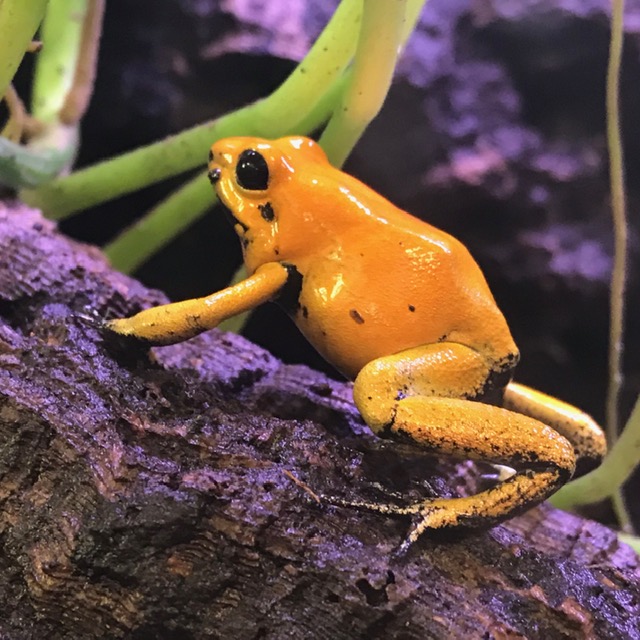Poison Dart Frog Care Guide
Poison Dart Frogs (Dendrobates spp. and Phyllobates spp.)
Species info: Poison dart frogs are a family of small to very small frogs native to South American rainforests. They get their name from the few extremely toxic species that Amazonian tribes rub their arrows on for easier hunting (luckily the toxin is deactivated by heat). Because the toxin is obtained from eating toxic insects, captive bred dart frogs never actually become toxic, and wild dart frogs will eventually lose their toxicity when put on a standard captive diet after a couple years.
Level of Care/Handling: Easy-medium. In an enclosure that has been set up well, both enclosure and animal maintenance are fairly minimal compared to other amphibians. The dart frogs themselves, however, are small and fragile. They should only ever be handled when absolutely necessary and with thoroughly washed hands, wetted latex gloves, etc.
Length/Lifespan: No species of poison dart frog gets larger than 3 in. from snout to vent, with 1-2 in. being the average. The average lifespan for captive dart frogs seems to oscillate around 6-10 years, but some individuals have been known to live much longer.
Temperature/Humidity/Lighting/Space Requirements: Enclosure temperatures should stay between 70-80 degrees, anything higher can kill your frog(s) relatively quickly. Humidity should never drop under 80% and your dart frogs will appreciate as close to 100% as you can keep it without oversaturating enclosure plants and substrate. UV lighting is not necessary, and overhead heat lamps should not be used as they make humidity more difficult to maintain. Fluorescent or LED grow lights, however, are necessary for keeping live plants. For space, one adult dart frog can comfortably live in a 5-10 gallon enclosure (depending on the size of the species). Dart frogs also do well living communally. A good rule of thumb is to add 5-10 gallons (again, depending on the size of the species) for every frog in the tank. New additions should kept in a small container (sterilite bin or something similar) for a week or more before getting introduced to their permanent enclosure. The ideal dart frog tank is glass with a glass lid, but a screen lid lined with saran wrap works just as well.
Tank Flooring: Substrates like organic topsoil that contains no fertilizers or pesticides are ideal for supporting tropical plant life, but avoid those that contain large amounts of peat moss as they are too acidic for use with amphibians. From the bottom up, the ideal vivarium setup has a drainage layer, mesh screen separator, soil, thin layer of spag moss, and leaf litter on top.
Tank Decoration: As dart frogs do best in a heavily-planted vivarium, the majority of decoration should be plant life. Suitable plants include tropicals, ferns, and air plants like bromeliads. Small hides are recommended as well.
Diet: Dart frogs are strict insectivores and as such should only be fed insects. Great staples include flightless fruit flies and pinhead crickets. If you make use of springtails and/or isopods to facilitate waste breakdown, your dart frog can eat these as well. Insects should be dusted every other feeding with calcium and multivitamin supplements designed for amphibians. We use Repashy Calcium Plus and Vitamin A Plus with our frogs.
Feeding Frequency: Froglets and juveniles should be fed daily, around 20-60 food items each depending on the size and species (this seems like a lot but is necessary because of how small the insects need to be). Adults can be feed once every 2-3 days but can occasionally go a week between feedings if already well established.

Contact us now!
Fill the form below and we will contact you shortly or please call 781-729-0135
News & Updates
Understanding Hermann’s Tortoise Size: A Comprehensive Guide
Hermann’s tortoises are captivating reptiles that have become popular among pet enthusiasts and reptile lovers. These small to medium-sized tortoises are known for their stunning appearance and gentle demeanor. If…
Read MoreStore Hours
- Tuesday
- 12:00 pm – 7:00 pm
- Wednesday
- 12:00 pm – 7:00 pm
- Thursday
- 12:00 pm – 7:00 pm
- Friday
- 12:00 pm – 7:00 pm
- Saturday
- 10:00 am – 7:00 pm
- Sunday
- 11:00 am – 5:00 pm
